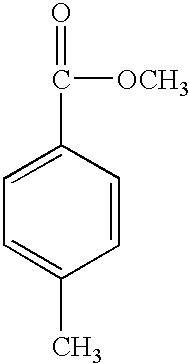Polyol containing glycol adduct for use in producing rigid foam
a polyol adduct and foam technology, applied in the direction of chemistry apparatus and processes, other chemical processes, etc., can solve the problems of putting severe burdens and costs on the users of hcfcs and cfcs, and cfcs, and achieving the effect of reducing the amount of isocyanate in the composition
- Summary
- Abstract
- Description
- Claims
- Application Information
AI Technical Summary
Benefits of technology
Problems solved by technology
Method used
Image
Examples
example 1
[0041] Example 1 illustrates the preparation of conventional polyester polyols. Weights of the reaction components are shown in Table 1. The components are charged to a reaction flask fitted with a mechanical stirrer, Vigreaux column, reflux condenser, reflux receiver, thermometer well, thermometer and temperature controller, and a nitrogen blanket. Reactor contents were gradually heated to 235.degree. C. while the distillate was collected and weighed. The reaction was terminated after 2-4 hours, when the overhead condenser temperature dropped to <50.degree. C. and the product acid number was less than 1.5. "B side stability" is the stability of the mixture of polyol and blowing agent, with any applicable catalysts, surfactants, or other traditional additives. The emulsion was conditioned at 25.degree. C., using 23 parts of pentane / 100 parts of polyol.
3TABLE 1 Example 1.1 1.2 1.3 Component, grams Phthalic Anhydride 272 0 0 DMT (dimethyl terephthalate) 0 275 0 DMT Residue 0 0 275 Die...
example 2
Conventional Example 2
[0043] Conventional Foam Forming Formulation
[0044] Example 2 illustrates a conventional foam forming procedure using a hydrocarbon blowing agent, here pentane. Ingredients shown in Table 2 are charged to a suitable container, in the order shown. The pentane mixture is added last, mixed, and adjusted to constant weight. The premixed `B-side` is then placed in a water bath and adjusted to 25.degree. C. Polymeric isocyanate, also at 25.degree. C., is then added and the total is mixed at 5000 rpm for 8 seconds. After mixing, the material is poured into a suitable mold, and the reactivity times are recorded. Foam is allowed to cure for 24-48 hours, and then cut for physical property testing.
4TABLE 2 Terate 2541 is commercially available polyester polyol from KoSa. TCCP is tris(2-chloropropyl phosphate), a flame retardant Polyol Hydroxyl Number 240 Terate 2541 100 parts by weight TCPP 15 K-octoate (catalyst) 4.2 Polycat-5 0.15 Silicone Surfactant 2.5 Water 0.5 Pentan...
example 3
[0045] Synthesis of Polyols of the Invention
[0046] Table 3 shows the physical properties for polyols produced by the procedure shown in Example 1, using conventional polyester polyol synthesis.
5TABLE 3 Polyol Designation 8256-56-2 8256-82 8256-86 8256-68 Parts by weight: DMT Residue 1160 836 711 873 Methyl benzoate 690 0 0 0 Methyl p-toluate 0 182 213 0 2-naphthol 0 0 0 198 Diethylene glycol 1773 800 955 654 Tetraisopropyltitanate 1.8 1.2 0.7 0.8 Total 3624.8 1819.2 1879.7 1725.8 Reaction Temperature, C. 230 230 225 225 Reaction Time, hours 4.00 3.75 4.75 6.00 Distillate, grams 479 230 95 271 Hydroxyl number, mg.KOH / gr. 237 258 251 248 Viscosity, cps 3600 2600 4500 17,500 Acid number, mg.KOH / gr. 0.9 0.3 0.3 0.6 Emulsion stability (24 Hr) Yes Yes Yes Yes Foam designation in Example 4 C D E F
[0047] The physical properties of the polyols produced in accordance with this invention, show improved polyol stability over those polyols produced by traditional methods shown in Example 1. The ...
PUM
| Property | Measurement | Unit |
|---|---|---|
| reaction time | aaaaa | aaaaa |
| density | aaaaa | aaaaa |
| weight % | aaaaa | aaaaa |
Abstract
Description
Claims
Application Information
 Login to View More
Login to View More - R&D
- Intellectual Property
- Life Sciences
- Materials
- Tech Scout
- Unparalleled Data Quality
- Higher Quality Content
- 60% Fewer Hallucinations
Browse by: Latest US Patents, China's latest patents, Technical Efficacy Thesaurus, Application Domain, Technology Topic, Popular Technical Reports.
© 2025 PatSnap. All rights reserved.Legal|Privacy policy|Modern Slavery Act Transparency Statement|Sitemap|About US| Contact US: help@patsnap.com

